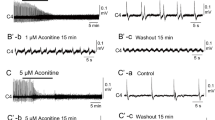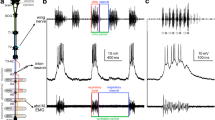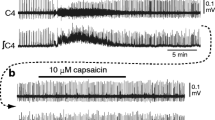Abstract
-
1.
Sensory axons from crab (Carcinus maenas) scaphognathites enter the thoracic ganglion primarily via the LNb branch of the levator nerve. The LNa branch of the levator nerve and the depressor nerve each contain relatively few sensory axons.
-
2.
Acutely deafferented ventilatory central pattern generators show a free running burst rate which is lower than that observed in intact crabs. Electrical stimulation of the levator nerve, or of its LNb branch, increases the burst rate in a frequency dependent manner. Stimulation at high enough intensity to recruit afferents will restart a paused motor rhythm. Stimulation of the levator nerve with short pulse trains phase resets and can entrain the rhythm.
-
3.
In addition to increasing the burst rate, LNb stimulation also causes a progressive elimination of motor neurons from the bursts as the stimulating frequency increases, probably due to depolarization of the 3 oval organ ‘giant’ afferent axons in this branch. Intracellular depolarization of single oval organ afferents will also inhibit some motor neurons as well as slow or stop the rhythm.
-
4.
Continuous stimulation of the depressor nerve does not affect the ganglionic burst rate and this nerve contains only a few small diameter afferent axons; however, brief trains of stimuli can reset the rhythm in a phase-dependent manner.
Similar content being viewed by others
Abbreviations
- bts-mirr−1 :
-
bursts/min
- CPGv :
-
ventilatory central pattern generator
- DN:
-
nerve supplying all depressor muscles of SG except D2a group
- LN:
-
levator nerve
- LNa:
-
branch of LN carrying motor neurons to all levator muscles
- LNb:
-
branch of LN carrying D2a depressor motor neurons
- MN:
-
motor neuron
- OOA:
-
oval organ afferent
- PG:
-
intact animal pattern generator
- PRC:
-
phase response curve
- SG:
-
scaphognathite
- SN:
-
nerve to endites of 2nd maxilla
References
Barnes WJP, Gladden MH (eds) (1985) Feedback and motor control in invertebrates and vertebrates. Croom Helm, London
Bässler U (1986a) On the definition of central pattern generator and its sensory control. Biol Cybern 54:65–69
Bässler U (1986b) Afferent control of walking movements in the stick insect Cunicula impigra. II. Reflex reversal and the release of the swing phase in the restrained foreleg. J Comp Physiol A 158:351–362
Bässler U, Wegner U (1983) Motor output of the denervated thoracic ventral nerve cord in the stick insect Carausius morosus. J Exp Biol 105:127–145
Cloney RA, Florey E (1968) Ultrastructure of cephalopod chromatophore organs. Z Zellforsch 89:250–280
Delcomyn F (1980) Neural basis of rhythmic behavior in animals. Science 210:492–498
DiCaprio RA (1989) Nonspiking interneurons in the ventilatory central pattern generator of the shore crab, Carcinus maenas. J Comp Neurol 285:83–106
DiCaprio RA (1990) An interneurone mediating motor programme switching in the ventilatory system of the crab. J Exp Biol 154:517–535
DiCaprio RA, Fourtner CR (1984) Neural control of ventilation in the shore crab, Carcinus maenas. I. Scaphognathite motor neurons and their effect on the ventilatory rhythm. J Comp Physiol A 155:397–405
DiCaprio RA, Fourtner CR (1988) Neural control of ventilation in the shore crab, Carcinus maenas. II. Frequency-modulating interneurons. J Comp Physiol A 162:375–388
Govind CK, Blundon JA, Kirk MD (1992) Functional degeneration of isolated central stumps of crayfish sensory axons. J Comp Neurol 322:111–120
Harris-Warrick R, Katz PS (1990) Sensory modulation of motor pattern generators in the crab stomatogastric ganglion. In: Wiese K, Krenz W-D, Tautz J, Reichert H, Mulloney B (eds) Frontiers in crustacean neurobiology. Birkhäuser, Basel, pp 431–438
Hughes GM, Knights B, Scammell CA (1969) The distribution of PO2 and hydrostatic pressure changes within the branchial chambers in relation to gill ventilation of the shore crab Carcinus maenas L. J Exp Biol 51:203–220
Luft JH (1961) Improvements in epoxy resin embedding methods. J Biophys Biochem Cytol 9:409–414
McMahon BR, Wilkens JL (1975) Respiratory and circulatory responses to hypoxia in the lobster Homarus americanus. J Exp Biol 62:637–655
McMahon BR, Wilkens JL (1977) Periodic respiratory and circulatory performance in the red rock crab Cancer productus. J Exp Zool 202:363–374
McMahon BR, Wilkens JL (1983) Ventilation, perfusion and oxygen uptake. In: Mantel LM, Bliss DE (eds) Biology of the Crustacea. Academic Press, New York, pp 289–372
Mendelson M (1971) Oscillator neurons in crustacean ganglia. Science 171:1170–1173
Miller JP (1975) Neuropil recording in the stomatogastric ganglion. Soc Neurosci Abstr 1:579
Moffett S (1977) Neuronal events underlying rhythmic behavior in invertebrates. Comp Biochem Physiol 57:187–195
Moody-Corbett F, Pasztor VM (1980) Innervation, synaptic physiology, and ultrastructure of three muscles of the second maxilla in crayfish. J Neurobiol 11:21–30
Pasztor VM (1968) The neurophysiology of respiration in decapod Crustacea. I. The motor system. Can J Zool 46:585–596
Pasztor VM (1969) The neurophysiology of respiration in decapod Crustacea. II. The sensory system. Can J Zool 47:435–441
Pasztor VM, Bush BMH (1983a) Graded potentials and spiking in single units of the oval organ, a mechanoreceptor in the lobster ventilatory system. I. Characteristics of dual afferent signalling. J Exp Biol 107:431–449
Pasztor VM, Bush BMH (1983b) Graded potentials and spiking in single units of the oval organ, a mechanoreceptor in the lobster ventilatory system. III. Sensory habituation to repetitive stimulation. J Exp Biol 107:465–472
Pearson J (1908) Cancer. Liverpool Mar Biol Comm Mem 16:1–209
Pearson KG (1987) Central pattern generation: A concept under scrutiny. In: Lennan HM, Ledsome DR, McIntosh CHS, Jones DR (eds) Advances in physiological research. Plenum Press, New York, pp 167–185
Pearson KG, Wolf H (1987) Comparison of motor patterns in the intact and deafferented flight system of the locust. I. Electromyographic analysis. J Comp Physiol A 160:259–268
Pearson KG, Wong RKS, Fourtner CR (1976) Connexions between hair-plate afferents and motoneurones in the cockroach leg. J Exp Biol 64:251–266
Pilkington JB, MacFarlane DW (1978) Numbers and central projections of crab second maxilla motor neurones. J Mar Biol Ass UK 58:571–584
Pilkington JB, Hogg JT, MacFarlane DW (1980) Propagation failure of antidromic action potentials in crab motor neurons. Comp Biochem Physiol 65A:215–218
Rajashekhar KP, Wilkens JL (1991) Control of ‘pulmonary’ pressure and coordination with gill ventilation in the shore crab Carcinus maenas. J Exp Biol 155:147–164
Rajashekhar KP, Wilkens JL (1992) Dopamine and nicotine, but not serotonin, modulate the crustacean ventilatory pattern generator. J Neurobiol 23:680–691
Reye DN, Pearson KG (1987) Projections of the wing stretch receptors to central flight neurons in the locust. J Neurosci 7:2476–2487
Richardson KC, Jarett L, Finke EH (1960) Embedding in epoxy resins for ultrathin sectioning in electron microscopy. Stain Technol 35:313–323
Simmers J, Bush BMH (1983a) Central nervous mechanisms controlling rhythmic burst generation in the ventilatory motoneurones of Carcinus maenas. J Comp Physiol 150:1–21
Simmers J, Bush BMH (1983b) Motor programme switching in the ventilatory system of Carcinus maenas: the neuronal basis of bimodal scaphognathite beating. J Exp Biol 104:163–181
Stewart WW (1978) Functional connections between cells as revealed by dyecoupling with a highly fluorescent naphthalimide tracer. Cell 14:741–759
Wendler G (1974) The influence of proprioceptive feedback on locust flight co-ordination. J Comp Physiol 88:173–200
Wilkens JL (1994) Degeneration of afferent neurons and long-term stability of the ventilatory central pattern generator in chronically deafferented crabs. J Comp Physiol A 174:211–220
Wilkens JL, McMahon BR (1972) Aspects of branchial irrigation in the lobster Homarus americanus. I. Functional analysis of scaphognathite beat, water pressures and currents. J Exp Biol 56:469–479
Wilkens JL, Young RE (1975) Patterns and bilateral co-ordination of scaphognathite rhythms in the lobster Homarus americanus. J Exp Biol 63:219–235
Wilkens JL, Mercier AJ, Evans J (1985) Cardiac and ventilatory responses to stress and to neurohormonal modulators by the shore crab, Carcinus maenas. Comp Biochem Physiol 82C:337–343
Wilkens JL, Young RE, DiCaprio RA (1989) Responses of the isolated crab ventilatory central pattern generators to variations in oxygen tension. J Comp Physiol B 159:29–36
Wilson DM (1961) The central nervous control of flight in a locust. J Exp Biol 38:471–490
Wilson DM, Gettrup E (1963) A stretch reflex controlling wingbeat frequency in grasshoppers. J Exp Biol 40:171–185
Wilson DM, Wyman RJ (1965) Motor output patterns during random and rhythmic stimulation of locust thoracic ganglia. Biophys J 5:121–143
Wolf H, Pearson KG (1987) Comparison of motor patterns in the intact and deafferented flight system of the locust. II. Intracellular recordings from flight motoneurons. J Comp Physiol A 160:269–279
Wolf H, Pearson KG (1989) Comparison of motor patterns in the intact and deafferented flight system of the locust. III. Patterns of interneuronal activity. J Comp Physiol A 165:61–74
Wood RL, Luft JH (1965) The influence of buffer systems on fixation with osmium tetroxide. J Ultrastruct Res 12:22–45
Young RE (1975) Neuromuscular control of ventilation in the crab Carcinus maenas. J Comp Physiol 101:1–37
Young RE, Coyer PE (1979) Phase co-ordination in the cardiac and ventilatory rhythms of the lobster Homarus americanus. J Exp Biol 82:53–74
Zinebi H, Simmers J, Truchot JP (1990) A peripheral arterial O2 sensitive pathway to the respiratory oscillator of the shore crab Carcinus maenas. J Exp Biol 148:181–199
Author information
Authors and Affiliations
Rights and permissions
About this article
Cite this article
Wilkens, J.L., DiCaprio, R.A. Effects of scaphognathite nerve stimulation on the acutely deafferented crab ventilatory central pattern generator. J Comp Physiol A 174, 195–209 (1994). https://doi.org/10.1007/BF00193786
Accepted:
Issue Date:
DOI: https://doi.org/10.1007/BF00193786




